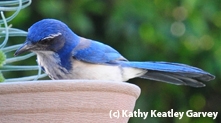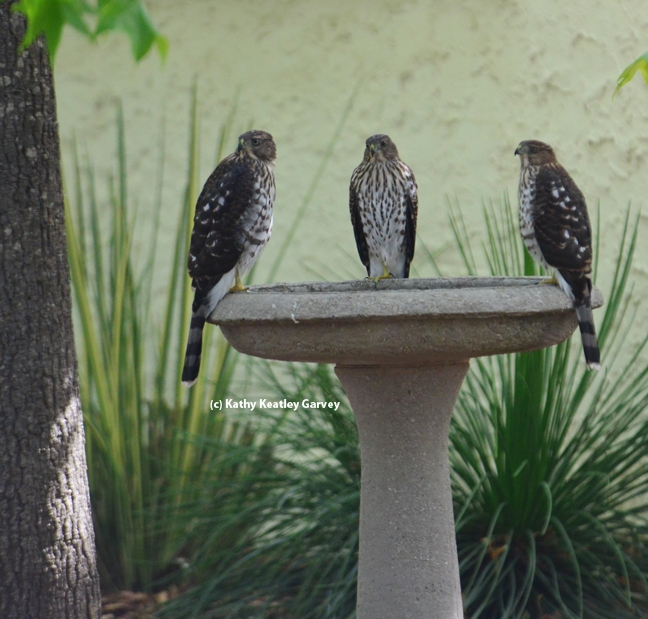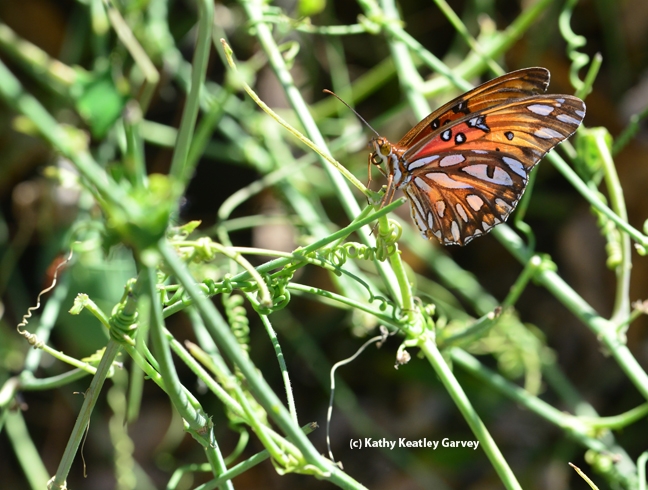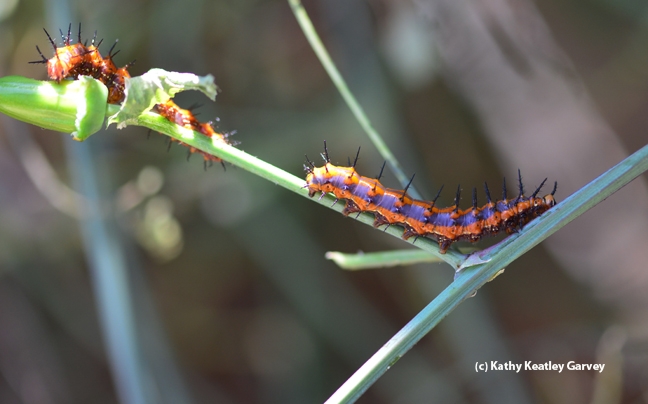
--John Muir, My First Summer in the Sierra
Muir said it well.
Muir (1938-1914), the naturalist and conservationist known as "The Father of Our National Parks," was the driving force behind the establishment of our national parks, including Yosemite National Park.
But have you ever thought about what he said: ""When we try to pick out anything by itself, we find it hitched to everything else in the Universe"?
In our yard, we are rearing Gulf Fritillary butterflies (Agraulis vanillae) on their host plant, the passionflower vine. The Gulf Frit is a bright orangish-reddish butterfly with silver-spangled underwings. It's a member of the family Nymphalidae and subfamily Heliconiinae.
We also consider it part of our family. The females and males mate, the females lay eggs on the passionflower vine, the eggs become caterpillars and the caterpillars become adults. That is, if the Western scrub jays and the praying mantids and the European paper wasps let them.
Lately, the caterpillars seem to be multiplying faster than the proverbial rabbits. The Western scrub jays are missing. They no longer sit on the fence and cherry-pick their prey. Why are they MIA? Three resident juvenile Cooper's hawks (as identified by Andrew Engilis, Jr., curator of the UC Davis Museum of Wildlife and Fish Biology) possess an appetite for jays (among other prey). The result: too many caterpillars on our passionflower vine. The 'cats are defoliating the plant faster than we expected. In short, it's a veritable population crisis on our passionflower vine.
"When we try to pick out anything by itself, we find it hitched to everything else in the Universe."
We love the caterpillars. We love the butterflies. We love the praying mantids. And we are trying our best to love, or at least like, the wasps after hearing researcher Amy Toth of Iowa State University speak fondly of them at UC Davis. Read the 10 things we should like about wasps. Note that she's trying to popularize the hashtag, #wasplove.
Meanwhile, what about those hawks? It's hawk heaven here. We love seeing them cooling their toes, splashing around in our front-yard birdbath, and communicating with their siblings. It's a sign of the times. California's severe drought means an influx of critters, large and small, heading for urban birdbaths. In addition to hawks, our birdbath draws squirrels, doves, finches, woodpeckers, scrub jays, sparrows, crows, honey bees and even a passing wild turkey with a neck long enough to reach the water.
Lately, it's a hawk birdbath. The jays are gone. The caterpillars are thriving.
"When we try to pick out anything by itself, we find it hitched to everything else in the Universe."
Attached Images:

Three's company! Three juvenile Cooper's hawks, as identified by Andrew Engilis, Jr. curator of the UC Davis Museum of Wildlife and Fish Biology,cooling off in an urban birdbath in Vacaville. (Photo by Kathy Keatley Garvey)

A Gulf Fritillary gets ready to lay an egg. (Photo by Kathy Keatley Garvey)

Gulf Fritillary caterpillars defoliating the passionflower vine. (Photo by Kathy Keatley Garvey)